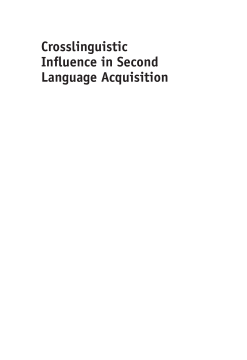
Additional Information
Book Details
Abstract
This volume provides an unprecedented insight into current approaches to crosslinguistic influence (CLI). The collection investigates a range of themes including linguistic relativity, the possible contributions of neurolinguistics, the problem of cognitive development and the role of the frequency of structures in acquisition from distinct, overlapping and complementary perspectives. Chapters focusing on vocabulary, morphosyntactic categories, semantic structures, and phonetic and phonological structures feature in the volume, as do over 20 languages, in order to offer new insights into both theoretical and empirical issues in CLI, including the consequences of great or little similarity in structures between languages. The relevance of CLI research for teaching is discussed in a number of chapters, as is the phenomenon of multilingualism. The collection will appeal to researchers, graduate and postgraduate students, teachers and professionals interested in the field of CLI in SLA.
The best minds working on crosslinguistic influence are gathered in this collection. The result is a fascinating empirical and intellectual journey of this field that all second language acquisition and bilingualism researchers must read!
Lourdes Ortega, Georgetown University, USA
Rosa Alonso Alonso holds a PhD in Linguistics from the University of Santiago de Compostela and works as an Associate Professor at the University of Vigo, Spain. Her research interests include crosslinguistic influence, motion events and academic writing. Since 2000 she has been the editor-in-chief of Vigo International Journal of Applied Linguistics.
Compared to more substantial anthologies on the market, this collection in affordable, thought-provoking and topical, earning its place on personal bookshelves as much as within institutional libraries.
Simon Williams, University of Sussex, UK
To improve our understanding of the role and nature of crosslinguistic influence remains a key task for research on SLA and bilingualism studies. This exciting volume presents new perspectives on this issue by leading scholars in the field, covering a wide range of topics, methods, and theoretical positions. It will be of interest to researchers, teachers and students alike.
Marianne Gullberg, Lund University, Sweden
Table of Contents
| Section Title | Page | Action | Price |
|---|---|---|---|
| Contents | v | ||
| Contributors | vii | ||
| Preface | xiii | ||
| 1 Was There Really Ever a Contrastive Analysis Hypothesis? | 1 | ||
| 2 Transfer and the Relationships Between the Languages of Multi-Competence | 24 | ||
| 3 Comprehension, Learning and Production of Foreign Languages: The Role of Transfer | 38 | ||
| 4 The Implications of Linguistic Relativity for Language Learning | 53 | ||
| 5 Crosslinguistic Lexical Influence: Cognate Facilitation | 71 | ||
| 6 Crosslinguistic Influence in the Acquisition of Spatial Prepositions in English as a Foreign Language | 93 | ||
| 7 Can Classroom Learners Use Statistical Learning? A New Perspective on Motion Event Construal in a Second Language | 121 | ||
| 8 L1-Fraught Difficulty: The Case of L2 Acquisition of English Articles by Slavic Speakers | 147 | ||
| 9 Learning Grammatical Gender in a Second Language Changes Categorisation of Inanimate Objects: Replications and New Evidence from English Learners of L2 French | 173 | ||
| 10 Crosslinguistic Influence in Third Language Acquisition | 193 | ||
| 11 Contemporary Perspectives on Crosslinguistic Influence | 215 | ||
| Index | 225 |
